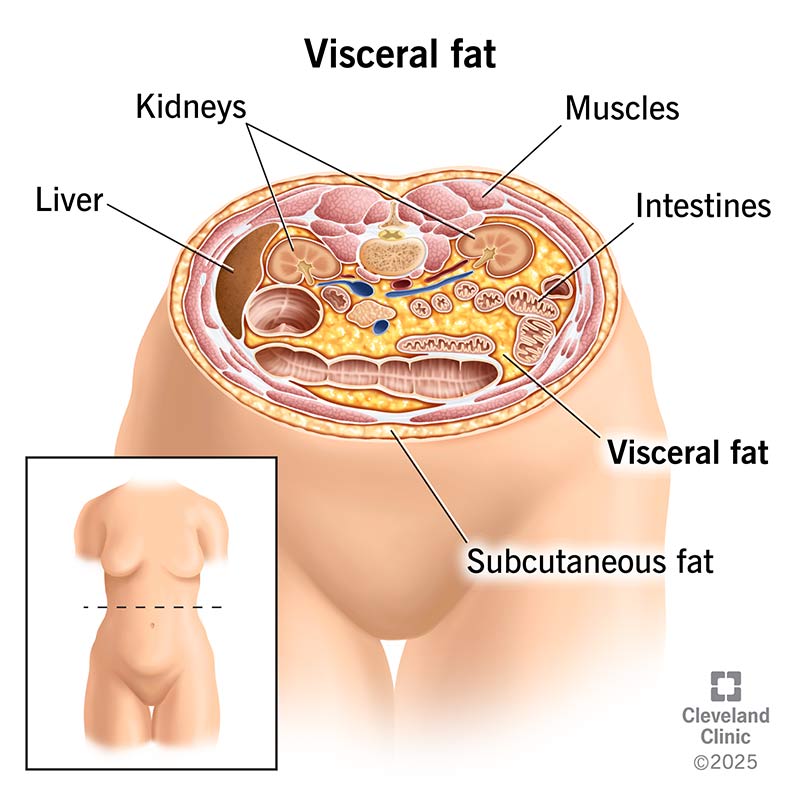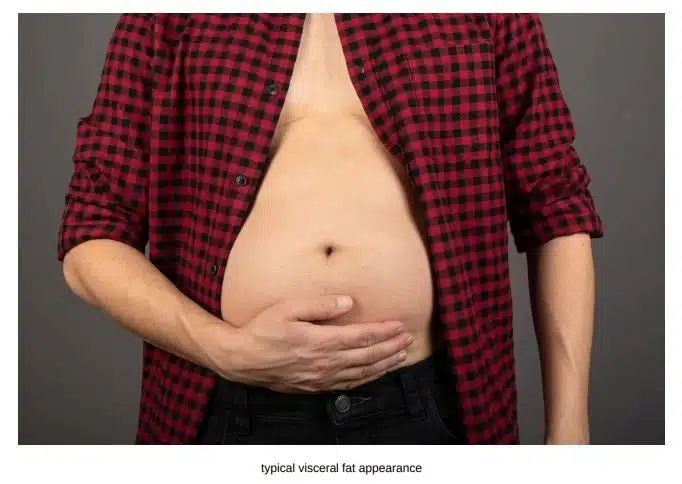Is Your Middle-Aged Spread Harmless, Or Is It Deadly?

As you reach your 50s, you might have noticed a rather insidious increase in your stomach girth. It creeps up slowly, usually without you noticing it, at first anyway.
Sometimes your partner is the first person to comment on your growing midriff!
Inevitably, you are the victim of the classic over 50s curse – middle-aged spread.
However, it’s not just as simple as that. The fat you have accumulated can generally be one of two types. Usually, it is either subcutaneous fat or visceral fat.
One form of fat is relatively harmless; the other is potentially life-threatening – I’m talking about visceral fat. It’s the kind you really do not want.
I will discuss the implications of visceral fat in the over 50s, and effective strategies to mitigate the risks.
As we age, various physiological changes are inevitable. One such change is the accumulation of visceral fat.
So What Exactly Is Visceral Fat?
Visceral fat is a type of body fat stored deep within the abdominal cavity.
It envelops vital organs like the liver and intestines, acting as a protective layer.
While a certain amount of visceral fat is necessary for maintaining organ health, an excess can lead to serious health complications.

This type of deep internal fat differs from subcutaneous fat, which resides just below the skin. Both types contribute to overall body fat, but the visceral variant poses more health risks.
Visceral Fat and The Health Risks
Extensive research has linked excessive visceral fat to an array of health issues. As the fat accumulates, it secretes hormones and chemicals that can be toxic to the body.
Here are some of the potential health risks associated with an abundance of visceral fat:
- High blood pressure
- An unhealthy amount of fat in the blood
- Sleep apnea
- Heart disease
- High blood sugar and diabetes
- Certain cancers
- Stroke
- Fatty liver
- Early death from any cause
These risks underline the importance of maintaining a low visceral fat level, particularly in individuals over 50.

The Over 50s And Visceral Fat
Aging often ushers in an increase in visceral fat.
Particularly for women, menopause marks a pivotal point where hormonal changes trigger a shift in fat distribution.
Previously stored predominantly in the hips and thighs, body fat gravitates towards the abdominal region.
This shift from a ‘pear’ to an ‘apple’ shape can result in significant visceral fat accumulation.
Men also experience increased abdominal fat as they age, although the change is gradual and steady.
Regardless of gender, these shifts in fat storage can contribute to the health risks I have mentioned above.
Factors Contributing to Visceral Fat Accumulation
Several factors come into play in the accumulation of visceral fat. These include:
- Diet and Physical Activity: Consuming excessive calories and leading a sedentary lifestyle can result in weight gain and, consequently, an increase in visceral fat.
- Aging: As we age, our metabolic rate slows down, and we lose muscle mass, which can lead to fat accumulation.
- Hormonal Changes: Hormonal shifts, particularly around menopause in women, can cause fat to redistribute and accumulate in the abdominal region.
- Genetics: Genetic factors can affect how your body stores fat and your susceptibility to gaining visceral fat.
Measuring Visceral Fat
Visceral fat is not directly visible, making its measurement slightly more complex than subcutaneous fat. However, several methods can provide an estimate:
- Waist Measurement: A simple tape measure can gauge your waist circumference. For women, a measurement exceeding 80 cm, and for men, over 94 cm, indicates an unhealthy amount of belly fat.
- Body Mass Index (BMI): BMI can estimate your overall body fat based on your weight and height.
- Waist-to-Hip Ratio: This involves dividing your waist size by your hip size. A higher ratio suggests abdominal obesity.
Strategies to Reduce Visceral Fat
While there’s no magic formula to specifically target visceral fat, certain lifestyle changes can help reduce overall body fat and, as a result, visceral fat.
Exercise
Physical activity is crucial in maintaining healthy body weight and reducing visceral fat. Both cardio and strength training exercises are beneficial.
- Aerobic Exercises: Brisk walking, running, or cycling can help burn calories and reduce body fat.
- Strength Training: Resistance or strength training can help maintain muscle mass, which aids in burning more calories, even at rest.
- High-Intensity Interval Training (HIIT): This exercise involves short, intense bursts of physical activity and short recovery periods. HIIT can help burn fat more effectively.
Healthy Diet
A balanced diet rich in fruits, vegetables, lean proteins, and whole grains can help manage body weight and reduce visceral fat. It’s also vital to limit the consumption of trans fats, refined sugars, and processed foods.
Adequate Sleep
Getting enough sleep is essential for overall health and weight management. Sleep deprivation can disrupt metabolism and lead to weight gain, including increased visceral fat.
Stress Management
Chronic stress can lead to hormonal changes that promote fat storage, particularly in the abdominal area. Incorporating stress management techniques such as yoga, meditation, or deep breathing can help.
Limit Alcohol Intake
Excessive alcohol consumption can contribute to weight gain and increased visceral fat. Therefore, it’s advisable to limit alcohol intake.
While visceral fat accumulation in over 50s is a common physiological phenomenon, it’s crucial to understand its potential health risks.
By adopting a healthy lifestyle that includes regular exercise, a balanced diet, adequate sleep, and stress management, it’s possible to manage visceral fat levels and mitigate associated health risks.
As always, consulting a healthcare provider for personalized advice and guidance is recommended.





